Influence of Imposed Strain on Weldability of Dievar Alloy
Abstract
:1. Introduction
2. Materials and Methods
3. Results and Discussion
3.1. Hot Compression Testing
3.2. Macrostructure Evaluation
3.3. Microstructure Evaluation Using Optical and SEM Microscopy
3.4. Analysis of Precipitates
3.5. Microhardness Evaluation
4. Conclusions
- Heat-treated sample welded at 70 A featured comparable size of HAZ as sample processed by rotary swaging and welded at 50 A, i.e., 2 mm,
- Heat-treated sample exhibited coarser (martensitic) structure compared to rotary swaged one,
- Compared to heat-treated sample, the rotary swaged one showed uniformly distributed fine (Mo, Cr, V)C precipitates,
- Rotary swaged and heat-treated samples had comparable microhardness (540 ± 10 HV0.2),
- Rotary swaged sample had twice as high strength as heat-treated sample (RS 1350 MPa and HT 650 MPa),
- Rotary swaged material will have a higher thermal stability (at 600 °C) than the heat-treated material, due to the higher number of carbides preventing the movement of dislocations observed in base material structure,
- In the case of heat-treated sample, higher heat input led to precipitation of carbides and increase in microhardness in HAZ (specifically in the highly overheated zone),
- During welding of rotary swaged sample, higher heat input resulted in dissolution of carbides into the solid solution and decrease in microhardness in HAZ,
- Weldability of rotary swaged sample was superior to that of heat-treated one (based on the microhardness profile in heat-affected zone).
Author Contributions
Funding
Data Availability Statement
Acknowledgments
Conflicts of Interest
References
- Kunčická, L.; Macháčková, A.; Petrmichl, R.; Klečková, Z.; Marek, M. Optimizing Induction Heating of WNiCo Billets Processed via Intensive Plastic Deformation. Appl. Sci. 2020, 10, 8125. [Google Scholar] [CrossRef]
- Macháčková, A.; Krátká, L.; Petrmichl, R.; Kunčická, L.; Kocich, R. Affecting Structure Characteristics of Rotary Swaged Tungsten Heavy Alloy Via Variable Deformation Temperature. Materials 2019, 12, 4200. [Google Scholar] [CrossRef] [PubMed]
- Volokitina, I.; Siziakova, E.; Fediuk, R.; Kolesnikov, A. Development of a Thermomechanical Treatment Mode for Stainless-Steel Rings. Materials 2022, 15, 4930. [Google Scholar] [CrossRef] [PubMed]
- Shlyakhova, G.V.; Orlova, D.V.; Danilov, V.I.; Danilova, L.V. Metastable Austenite Steel Structure After Thermomechanical Processing in Different Modes. Russ. Phys. J. 2021, 64, 1080–1085. [Google Scholar] [CrossRef]
- Moskvina, V.A.; Melnikov, E.V.; Astafurov, S.V.; Panchenko, M.Y.; Reunova, K.A.; Kolubaev, E.A.; Astafurova, E.G. Stable High-Nickel Austenitic Steel Produced by Electron Beam Additive Manufacturing Using Dual Wire-Feed System. Mater. Lett. 2021, 305, 130863. [Google Scholar] [CrossRef]
- Kutzhanov, M.K.; Matveev, A.T.; Kvashnin, D.G.; Corthay, S.; Kvashnin, A.G.; Konopatsky, A.S.; Bondarev, A.V.; Arkharova, N.A.; Shtansky, D.V. Al/SiC Nanocomposites with Enhanced Thermomechanical Properties Obtained from Microwave Plasma-Treated Nanopowders. Mater. Sci. Eng. A 2021, 824, 141817. [Google Scholar] [CrossRef]
- Kořínek, M.; Halama, R.; Fojtík, F.; Pagáč, M.; Krček, J.; Krzikalla, D.; Kocich, R.; Kunčická, L. Monotonic Tension-Torsion Experiments and FE Modeling on Notched Specimens Produced by SLM Technology from SS316L. Materials 2020, 14, 33. [Google Scholar] [CrossRef]
- Kunčická, L.; Kocich, R.; Németh, G.; Dvořák, K.; Pagáč, M. Effect of Post Process Shear Straining on Structure and Mechanical Properties of 316 L Stainless Steel Manufactured via Powder Bed Fusion. Addit. Manuf. 2022, 59, 103128. [Google Scholar] [CrossRef]
- Shakil, S.I.I.; Smith, N.R.R.; Yoder, S.P.P.; Ross, B.E.E.; Alvarado, D.J.J.; Hadadzadeh, A.; Haghshenas, M. Post Fabrication Thermomechanical Processing of Additive Manufactured Metals: A Review. J. Manuf. Process. 2022, 73, 757–790. [Google Scholar] [CrossRef]
- Kocich, R.; Kunčická, L.; Benč, M.; Weiser, A.; Németh, G. Corrosion Behavior of Selective Laser Melting-Manufactured Bio-Applicable 316L Stainless Steel in Ionized Simulated Body Fluid. Int. J. Bioprinting 2024, 10, 1416. [Google Scholar] [CrossRef]
- Al-Qawabeha, U.F. Effect of Heat Treatment on the Mechanical Properties, Microhardness, and Impact Energy of H13 Alloy Steel. Int. J. Sci. Eng. Res. 2017, 8, 6. [Google Scholar]
- Guanghua, Y.; Xinmin, H.; Yanqing, W.; Xingguo, Q.; Ming, Y.; Zuoming, C.; Kang, J. Effects of Heat Treatment on Mechanical Properties of H13 Steel. Met. Sci. Heat Treat. 2010, 52, 393–395. [Google Scholar] [CrossRef]
- Prudente, W.R.; Lins JF, C.; Siqueira, R.P.; Mendes PS, N.; Pereira, R.E. Microstructural evolution under tempering heat treatment in AISI H13 hot-work tool steel. Int. J. Eng. Res. Appl. 2017, 7, 67–71. [Google Scholar] [CrossRef]
- Fedoseeva, A.; Kaibyshev, R. Impact Toughness of a 12% Cr Martensitic Steel: Conventional Heat Treatment vs. Thermo- Krylova, T.A.; Chumakov, Y.A. Fabrication of Cr-Ti-C Composite Coating by Non-Vacuum Electron Beam Cladding. Mater. Lett. 2020, 274, 128022. [Google Scholar] [CrossRef]
- Gorunov, A. Experimental Investigation and Numerical Simulation of Synthesis Carbides in Inconel 718/CFs/316L Composite Obtained by Direct Energy Deposition. Prog. Addit. Manuf. 2024. [Google Scholar] [CrossRef]
- Stulov, Y.V.; Kuznetsov, S.A. Synthesis of Chromium Carbide Coatings on Carbon Steels in Molten Salts and Their Properties. Glas. Phys. Chem. 2014, 40, 324–328. [Google Scholar] [CrossRef]
- Yeşildal, R. The Effect of Heat Treatments on the Fatigue Strength of H13 Hot Work Tool Steel. Preprints 2018, 2018120226. [Google Scholar] [CrossRef]
- Dhokey, N.B.; Maske, S.S.; Ghosh, P. Effect of tempering and cryogenic treatment on wear and mechanical properties of hot work tool steel (H13). Mater. Today Proc. 2021, 43, 3006–3013. [Google Scholar] [CrossRef]
- Kunčická, L.; Kocich, R. Optimizing Electric Conductivity of Innovative Al-Cu Laminated Composites via Thermomechanical Treatment. Mater. Des. 2022, 215, 110441. [Google Scholar] [CrossRef]
- Wang, Z.; Chen, J.; Kocich, R.; Tardif, S.; Dolbnya, I.P.; Kunčická, L.; Micha, J.-S.; Liogas, K.; Magdysyuk, O.V.; Szurman, I.; et al. Grain Structure Engineering of NiTi Shape Memory Alloys by Intensive Plastic Deformation. ACS Appl. Mater. Interfaces 2022, 14, 31396–31410. [Google Scholar] [CrossRef]
- Klimova, M.; Shaysultanov, D.; Semenyuk, A.; Zherebtsov, S.; Stepanov, N. Effect of Carbon on Recrystallised Microstructures and Properties of CoCrFeMnNi-Type High-Entropy Alloys. J. Alloys Compd. 2021, 851, 156839. [Google Scholar] [CrossRef]
- Kumar, M.; King, W.E.; Schwartz, A.J. Modifications to the Microstructural Topology in f.c.c. Materials through Thermomechanical Processing. Acta Mater. 2000, 48, 2081–2091. [Google Scholar] [CrossRef]
- Caballero, F.G.; Santofimia, M.J.; García-Mateo, C.; Chao, J.; de Andrés, C.G. Theoretical Design and Advanced Microstructure in Super High Strength Steels. Mater. Des. 2009, 30, 2077–2083. [Google Scholar] [CrossRef]
- Hansen, N. Hall–Petch relation and boundary strengthening. Scr. Mater. 2004, 51, 801–806. [Google Scholar] [CrossRef]
- Straumal, B.B.; Kogtenkova, O.A.; Murashkin, M.Y.; Bulatov, M.F.; Czeppe, T.; Zięba, P. Grain Boundary Wetting Transition in Al–Mg Alloys. Mater. Lett. 2017, 186, 82–85. [Google Scholar] [CrossRef]
- Hlaváč, L.M.; Kocich, R.; Gembalová, L.; Jonšta, P.; Hlaváčová, I.M. AWJ Cutting of Copper Processed by ECAP. Int. J. Adv. Manuf. Technol. 2016, 86, 885–894. [Google Scholar] [CrossRef]
- Kocich, R.; Kunčická, L. Development of Structure and Properties in Bimetallic Al/Cu Sandwich Composite during Cumulative Severe Plastic Deformation. J. Sandw. Struct. Mater. 2021, 23, 4252–4275. [Google Scholar] [CrossRef]
- Straumal, B.B.; Pontikis, V.; Kilmametov, A.R.; Mazilkin, A.A.; Dobatkin, S.V.; Baretzky, B. Competition between Precipitation and Dissolution in Cu–Ag Alloys under High Pressure Torsion. Acta Mater. 2017, 122, 60–71. [Google Scholar] [CrossRef]
- Valiev, R.Z.; Straumal, B.; Langdon, T.G. Using Severe Plastic Deformation to Produce Nanostructured Materials with Superior Properties. Annu. Rev. Mater. Res. 2022, 52, 357–382. [Google Scholar] [CrossRef]
- Kunčická, L.; Kocich, R.; Ryukhtin, V.; Cullen, J.C.T.; Lavery, N.P. Study of Structure of Naturally Aged Aluminium after Twist Channel Angular Pressing. Mater. Charact. 2019, 152, 94–100. [Google Scholar] [CrossRef]
- Kunčická, L.; Kocich, R.; Drápala, J.; Andreyachshenko, V.A. FEM Simulations and Comparison of the Ecap and ECAP-PBP Influence on Ti6Al4V Alloy’s Deformation Behaviour. In Proceedings of the Metal 2013: 22nd International Metallurgical and Materials Conference, Brno, Czech Republic, 15–17 March 2013; Tanger Ltd.: Ostrava, Czech Republic, 2013; pp. 391–396. [Google Scholar]
- Yan, K.; Liu, H.; Feng, N.; Bai, J.; Cheng, H.; Liu, J.; Huang, F. Preparation of a Single-Phase Mg–6Zn Alloy via ECAP-Stimulated Solution Treatment. J. Magnes. Alloy. 2019, 7, 305–314. [Google Scholar] [CrossRef]
- Sheremetyev, V.; Churakova, A.; Derkach, M.; Gunderov, D.; Raab, G.; Prokoshkin, S. Effect of ECAP and Annealing on Structure and Mechanical Properties of Metastable Beta Ti-18Zr-15Nb (at.%) Alloy. Mater. Lett. 2021, 305, 130760. [Google Scholar] [CrossRef]
- Kunčická, L.; Lowe, T.C.; Davis, C.F.; Kocich, R.; Pohludka, M. Synthesis of an Al/Al2O3 Composite by Severe Plastic Deformation. Mater. Sci. Eng. A 2015, 646, 234–241. [Google Scholar] [CrossRef]
- Danilenko, V.N.; Kiekkuzhina, L.U.; Parkhimovich, N.Y.; Khafizova, E.D.; Gunderov, D.V. Cu-Al Metal Matrix Composite Fabricated by Accumulative HPT. Mater. Lett. 2021, 300, 130240. [Google Scholar] [CrossRef]
- Jamili, A.M.; Zarei-Hanzaki, A.; Abedi, H.R.; Mosayebi, M.; Kocich, R.; Kunčická, L. Development of Fresh and Fully Recrystallized Microstructures through Friction Stir Processing of a Rare Earth Bearing Magnesium Alloy. Mater. Sci. Eng. A 2019, 775, 138837. [Google Scholar] [CrossRef]
- Rogachev, S.O.; Sundeev, R.V.; Andreev, V.A.; Andreev, N.V.; Tabachkova, N.Y.; Korotkova, N.O. The Microstructure and Conductivity of Copper–Aluminum Composites Prepared by Rotary Swaging. Phys. Met. Metallogr. 2022, 123, 1193–1200. [Google Scholar] [CrossRef]
- Vinogradov, A.; Vasilev, E.; Kopylov, V.; Linderov, M.; Brilevesky, A.; Merson, D. High Performance Fine-Grained Biodegradable Mg-Zn-Ca Alloys Processed by Severe Plastic Deformation. Metals 2019, 9, 186. [Google Scholar] [CrossRef]
- Chuvil’deev, V.N.; Kopylov, V.I.; Nokhrin, A.V.; Tryaev, P.V.; Tabachkova, N.Y.; Chegurov, M.K.; Kozlova, N.A.; Mikhaylov, A.S.; Ershova, A.V.; Grayznov, M.Y.; et al. Effect of Severe Plastic Deformation Realized by Rotary Swaging on the Mechanical Properties and Corrosion Resistance of Near-α-Titanium Alloy Ti-2.5Al-2.6Zr. J. Alloys Compd. 2019, 785, 1233–1244. [Google Scholar] [CrossRef]
- Wang, Z.; Chen, J.; Besnard, C.; Kunčická, L.; Kocich, R.; Korsunsky, A.M. In Situ Neutron Diffraction Investigation of Texture-Dependent Shape Memory Effect in a near Equiatomic NiTi Alloy. Acta Mater. 2021, 202, 135–148. [Google Scholar] [CrossRef]
- Kocich, R.; Kunčická, L. Optimizing Structure and Properties of Al/Cu Laminated Conductors via Severe Shear Strain. J. Alloys Compd. 2023, 953, 170124. [Google Scholar] [CrossRef]
- Genel, K. Boriding kinetics of H13 steel. Vacuum 2006, 80, 451–457. [Google Scholar] [CrossRef]
- Jia, Z.X.; Liu, Y.W.; Li, J.Q.; Liu, L.J.; Li, H.L. Crack growth behavior at thermal fatigue of H13 tool steel processed by laser surface melting. Int. J. Fatigue 2015, 78, 61–71. [Google Scholar] [CrossRef]
- Wang, N.; Zhang, H.; Wei, Z.; Dong, P.; Yan, Z.; Ding, M.; Li, K. Solid Carburizing in Ferritic Phase Region of DIEVAR Steel: Microstructure Evolution and Formation Mechanism of Carburizing Layer. Surf. Coat. Technol. 2024, 476, 130200. [Google Scholar] [CrossRef]
- Brezinová, J.; Džupon, M.; Viňáš, J.; Vojtko, M.; Brezina, J.; Vasková, I.; Puchý, V. Possibilities of Repairing Functional Surfaces of Molds for Injecting Al Alloys Using Manual GTAW Cladding. Metals 2022, 12, 1781. [Google Scholar] [CrossRef]
- Hawryluk, M. Review of selected methods of increasing the life of forging tools in hot die forging processes. Arch. Civ. Mech. Eng. 2016, 16, 845–866. [Google Scholar] [CrossRef]
- Balaško, T.; Vončina, M.; Medved, J. Simultaneous Thermal Analysis of the High-Temperature Oxidation Behaviour of Three Hot-Work Tool Steels. J. Therm. Anal. Calorim. 2023, 148, 1251–1264. [Google Scholar] [CrossRef]
- Garbade, R.R.; Dhokey, N.B. Overview on Hardfacing Processes, Materials and Applications. IOP Conf. Ser. Mater. Sci. Eng. 2021, 1017, 12033. [Google Scholar] [CrossRef]
- Wang, X.H.; Han, F.; Liu, X.M.; Qu, S.Y.; Zou, Z.D. Effect of molybdenum on the microstructure and wear resistance of Fe-based hardfacing coatings. Mater. Sci. Eng. A Struct. Mater. Prop. Microstruct. Process. 2008, 489, 193–200. [Google Scholar] [CrossRef]
- Morsy, M.; El-Kashif, E. The effect of microstructure on high-stress abrasion resistance of Fe-Cr-C hardfacing deposits. Weld. World 2014, 58, 491–497. [Google Scholar] [CrossRef]
- Rajeev, G.P.; Kamaraj, M.; Bakshi, S.R. Hardfacing of AISI H13 tool steel with Stellite 21 alloy using cold metal transfer welding process. Surf. Coat. Technol. 2017, 326, 63–71. [Google Scholar]
- Rajeev, G.P.; Kamaraj, M.; Bakshi, S.R. Comparison of microstructure, dilution and wear behavior of Stellite 21 hardfacing on H13 steel using cold metal transfer and plasma transferred arc welding processes. Surf. Coat. Technol. 2019, 375, 383–394. [Google Scholar] [CrossRef]
- Kashani, H.; Amadeh, A.; Vatanara, M.R. Improvement of wear resistance of hot working tool steel by hardfacing Part 1—Effect of microstructure and hardness. Mater. Sci. Technol. 2007, 23, 165–170. [Google Scholar] [CrossRef]
- Kashani, H.; Amadeh, A.; Vatanara, M.R. Improvement of wear resistance of hot working tool steel by hardfacing Part 2—Case study. Mater. Sci. Technol. 2008, 24, 356–360. [Google Scholar] [CrossRef]
- Tian, J.; Hu, Y.; Zhao, H.; Hu, Y.; Li, Y.; Zhou, S.; Cao, C.; Zhang, L. The indentation and wear performance of hardfacing layers on H13 steel for use in high temperature application. AIP Adv. 2019, 9, 095304. [Google Scholar] [CrossRef]
- Wang, X.; Wang, J.; Gao, Z.; Xia, D.H.; Hu, W. Tempering effects on the microstructure and properties of submerged arc surfacing layers of H13 steel. J. Mater. Process. Technol. 2019, 269, 26–34. [Google Scholar] [CrossRef]
- Karmakar, D.P.; Muvvala, G.; Nath, A.K. High-temperature abrasive wear characteristics of H13 steel modified by laser remelting and cladded with Stellite 6 and Stellite 6/30% WC. Surf. Coat. Technol. 2021, 422, 127498. [Google Scholar] [CrossRef]
- Ahn, D.G. Hardfacing technologies for improvement of wear characteristics of hot working tools: A Review. Int. J. Precis. Eng. Manuf. 2013, 14, 1271–1283. [Google Scholar] [CrossRef]
- d’Oliveira, A.S.C.M.; Paredes, R.S.C.; Santos, R.L.C. Pulsed current plasma transferred arc hardfacing. J. Mater. Process. Technol. 2006, 171, 167–174. [Google Scholar] [CrossRef]
- Tandon, D.; Li, H.; Pan, Z.; Yu, D.; Pang, W. A Review on Hardfacing, Process Variables, Challenges, and Future Works. Metals 2023, 13, 1512. [Google Scholar] [CrossRef]
- Farahmand, P.; Balu, P.; Kong, F.; Kovacevic, R. Investigation of thermal cycle and hardness distribution in the laser cladding of AISI H13 tool steel produced by a high power direct diode laser. In Proceedings of the ASME International Mechanical Engineering Congress and Exposition, San Diego, CA, USA, 15–21 November 2013; American Society of Mechanical Engineers: New York, NY, USA, 2014; Volume 2. [Google Scholar] [CrossRef]
- Shah, M.; Ali, M.; Sultan, A.; Mujahid, M.; Mehmood, H.; Dar, N.U.; Shuaib, M. An Investigation into the Fatigue Crack Growth Rate of Electron Beam-Welded H13 Tool Steel: Effect of Welding and Post-Weld Heat Treatment. Metallogr. Microstruct. Anal. 2014, 3, 114–125. [Google Scholar] [CrossRef]
- Okechukwu, C.; Dahunsi, O.A.; Oke, P.K.; Oladele, I.O.; Dauda, M. Review on hardfacing as method of improving the service life of critical components subjected to wear in service. Niger. J. Technol. 2018, 36, 1095. [Google Scholar] [CrossRef]
- Han, Y.; Li, C.; Ren, J.; Qiu, C.; Li, E.; Chen, S. Characterization of Hot Deformation Behavior and Processing Map of As-Cast H13 Hot Work Die Steel. Met. Mater. Int. 2021, 27, 3574–3589. [Google Scholar] [CrossRef]
- Li, C.; Liu, Y.; Tan, Y.; Zhao, F. Hot deformation behavior and constitutive modeling of H13-mod steel. Metals 2018, 8, 846. [Google Scholar] [CrossRef]
- He, G.; Feng, Y.; Jiang, B.; Wu, H.; Wang, Z.; Zhao, H.; Liu, Y. Corrosion and Abrasion Behavior of High-Temperature Carburized 20MnCr5 Gear Steel with Nb and B Microalloying. J. Mater. Res. Technol. 2023, 25, 5845–5854. [Google Scholar] [CrossRef]
- Lange, K.; Cser, L.; Geiger, M.; Kals, J.A.G. Tool Life and Tool Quality in Bulk Metal Forming. CIRP Ann. 1992, 41, 667–675. [Google Scholar] [CrossRef]
- Medvedeva, N.I.; Van Aken, D.C.; Medvedeva, J.E. Stability of Binary and Ternary M23C6 Carbides from First Principles. Comput. Mater. Sci. 2015, 96, 159–164. [Google Scholar] [CrossRef]
- Köse, C. Effect of Post-Weld Heat Treatment on Microstructure, Crystallography, and Mechanical Properties of Laser Beam Welded AISI 904L Super Austenitic Stainless Steel. Eng. Fail. Anal. 2024, 158, 108025. [Google Scholar] [CrossRef]
- Han, H.G.; Wang, F.; Lu, Y.H.; Han, Y.M.; Chen, Z.Z. A Study on As-Welded Microstructure and Mechanical Properties of Thick-Walled 9Cr3W3Co1CuVNbBN Martensitic Steel Weldment. Int. J. Press. Vessel. Pip. 2023, 206, 105077. [Google Scholar] [CrossRef]

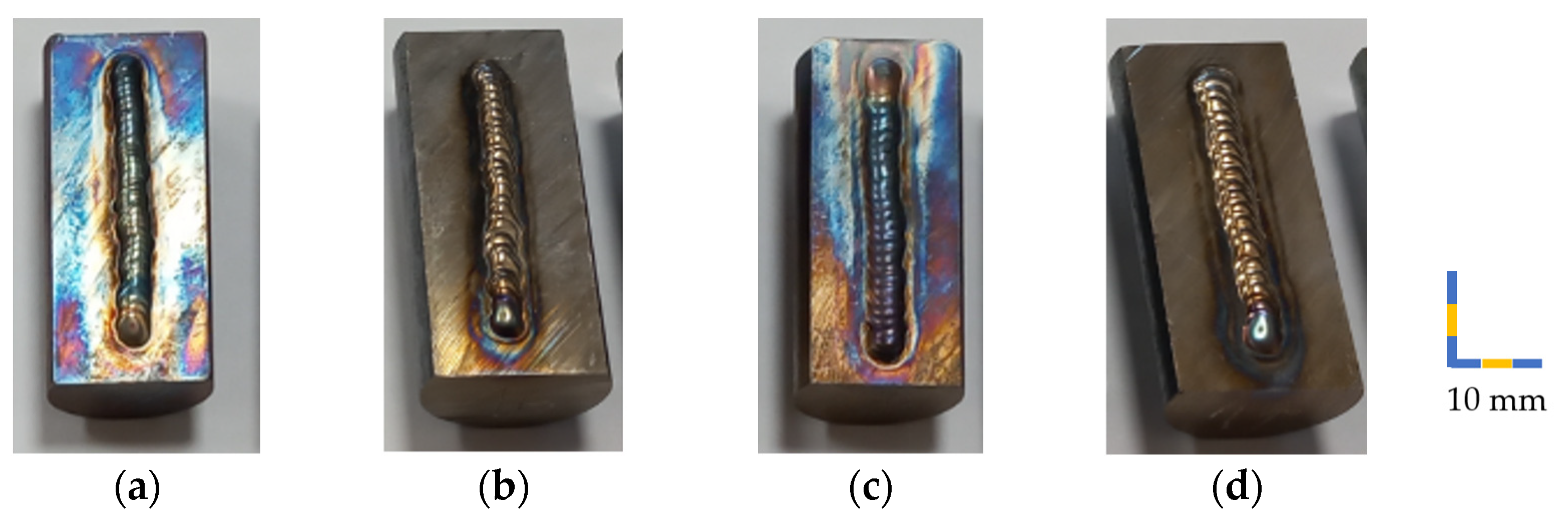

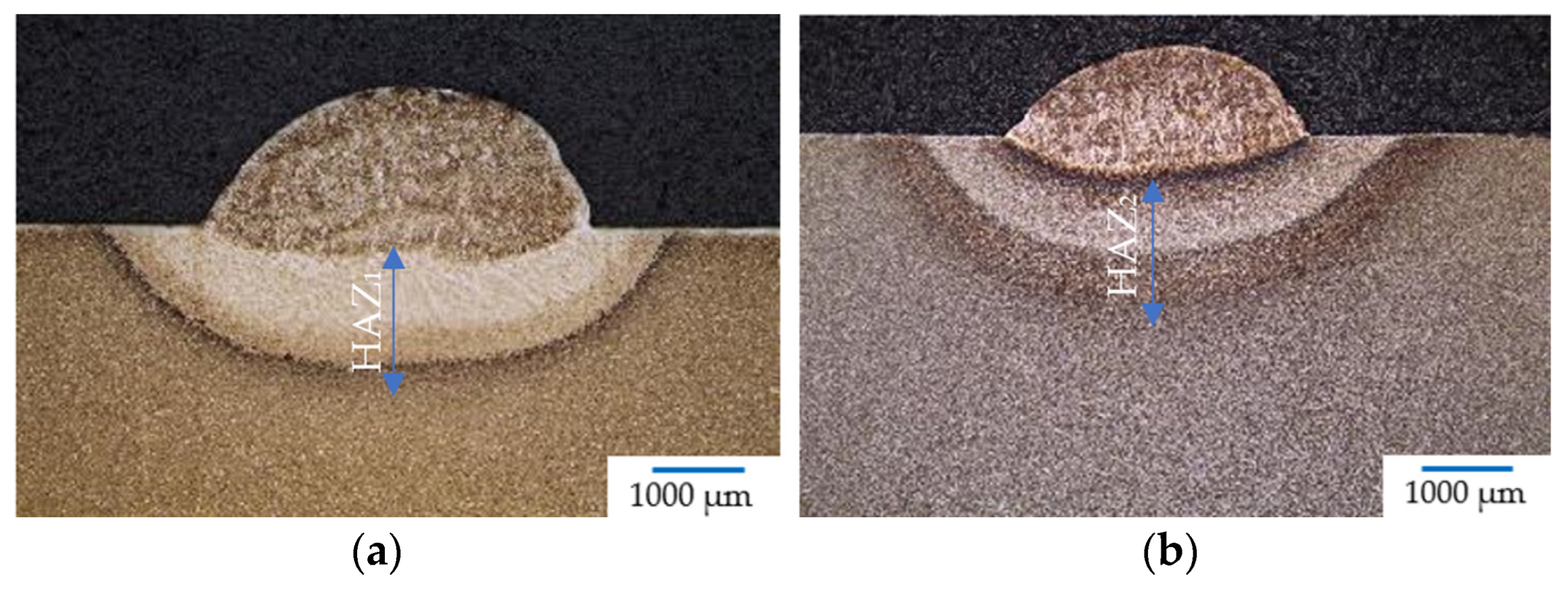

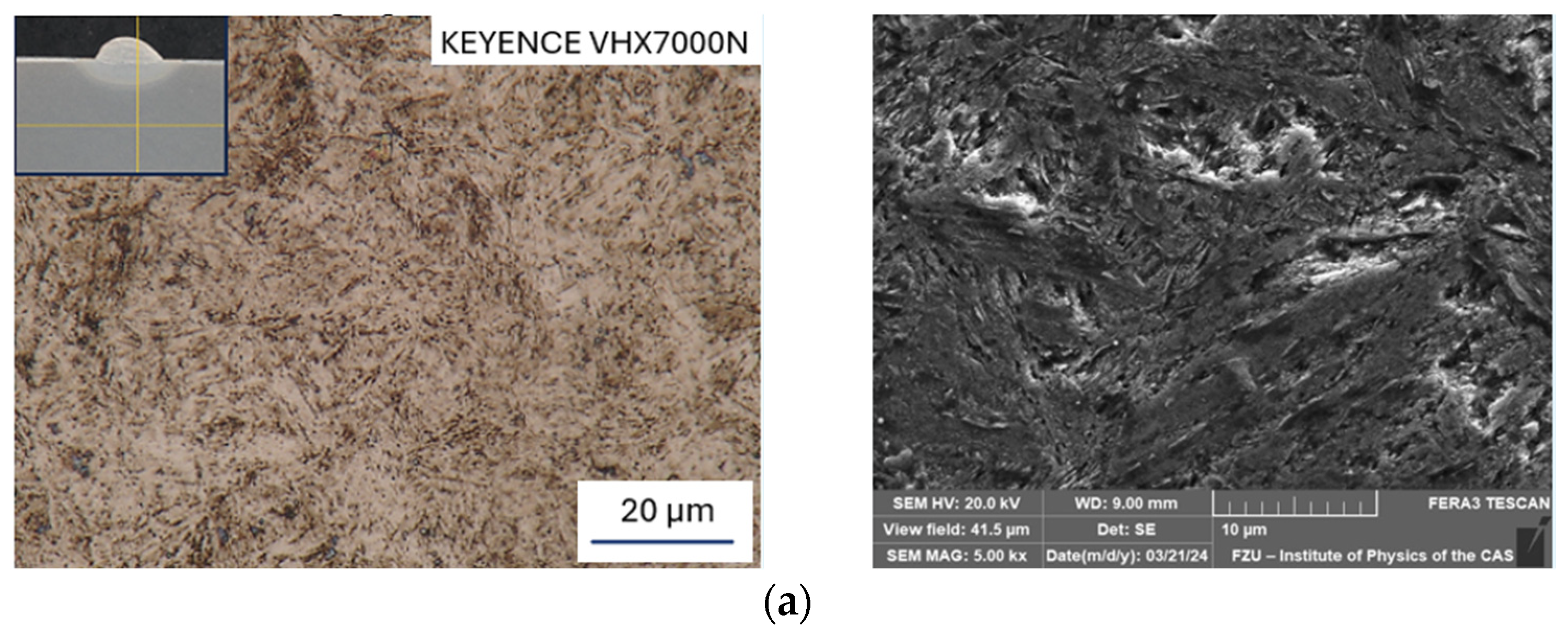

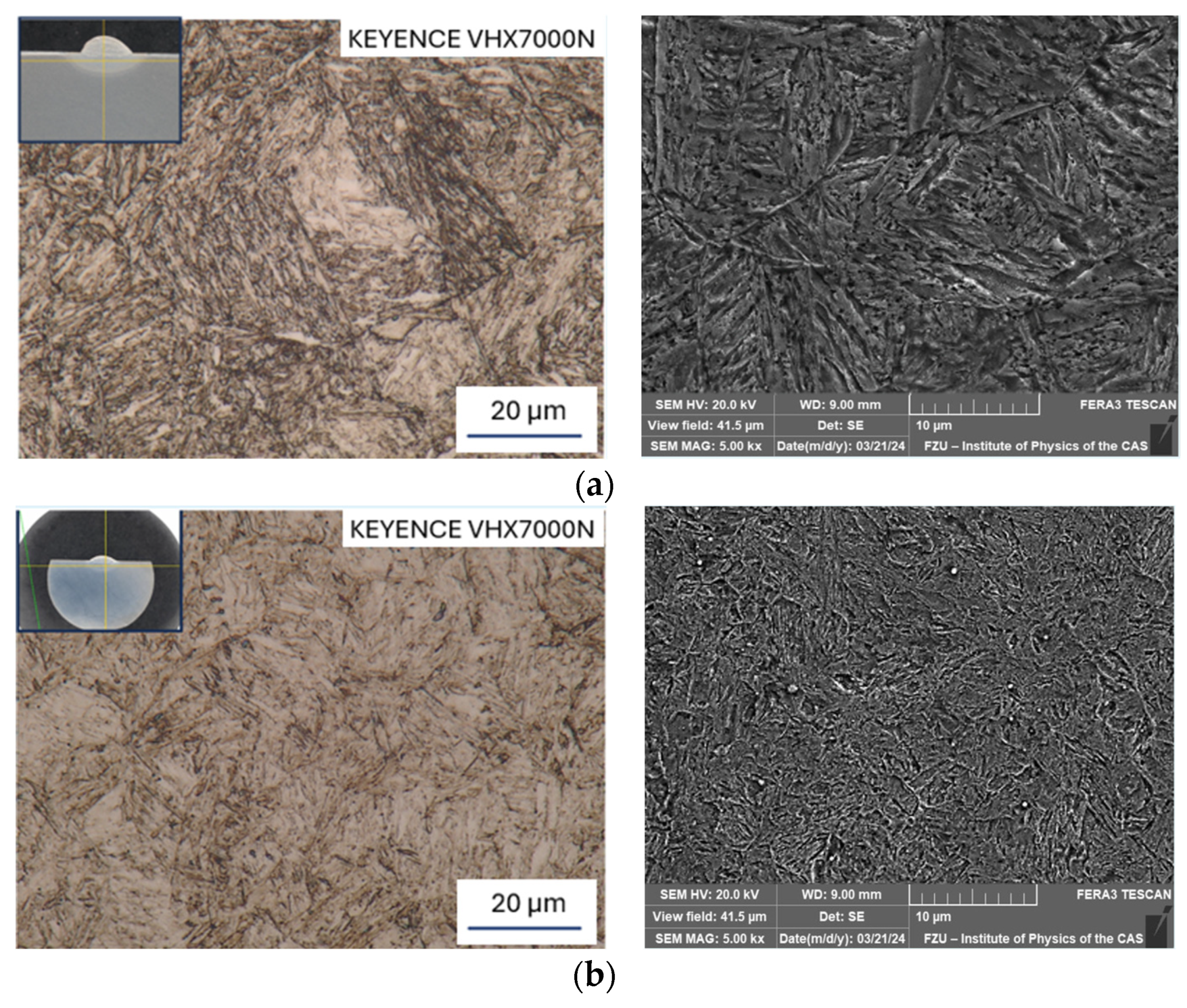

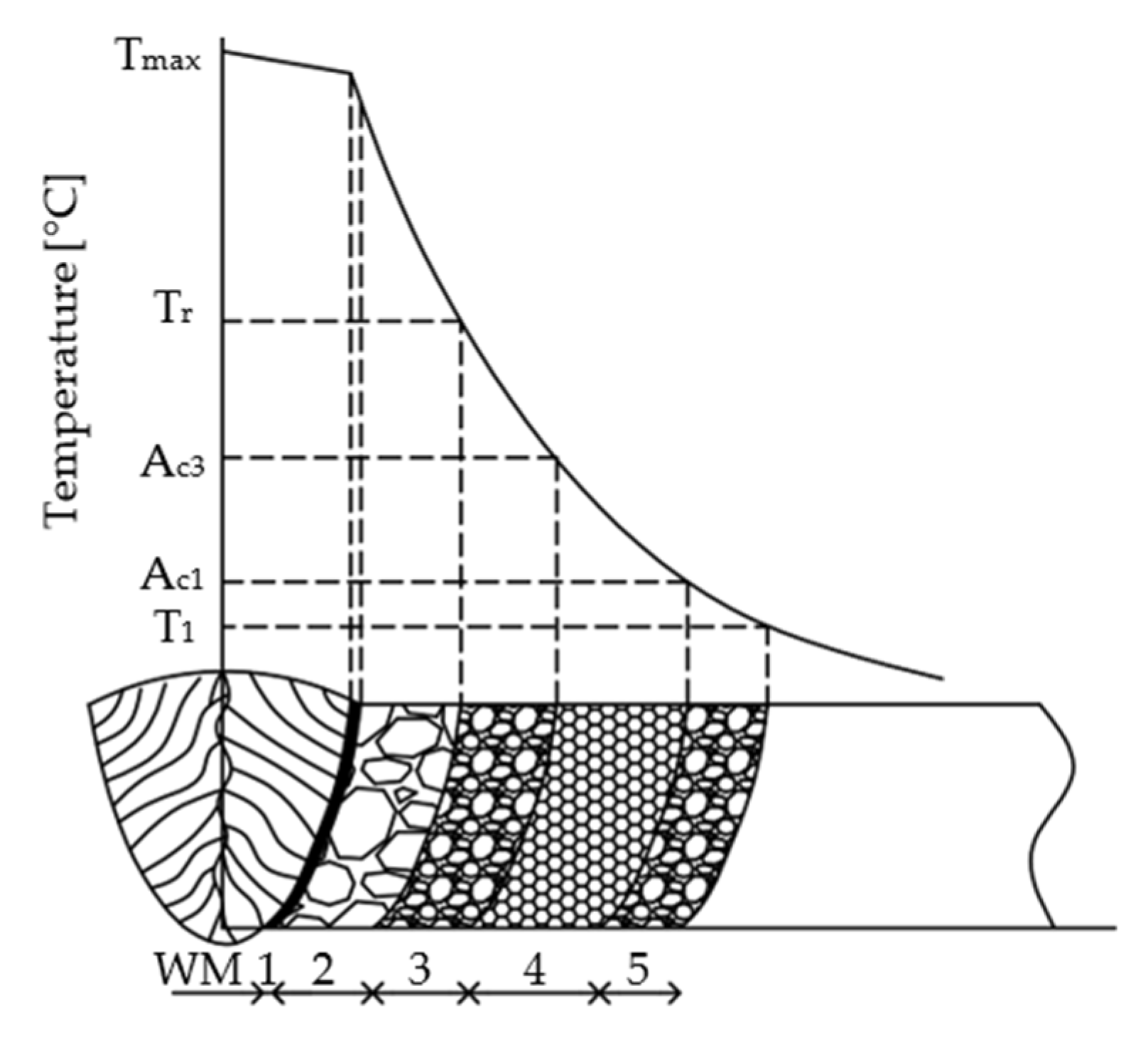

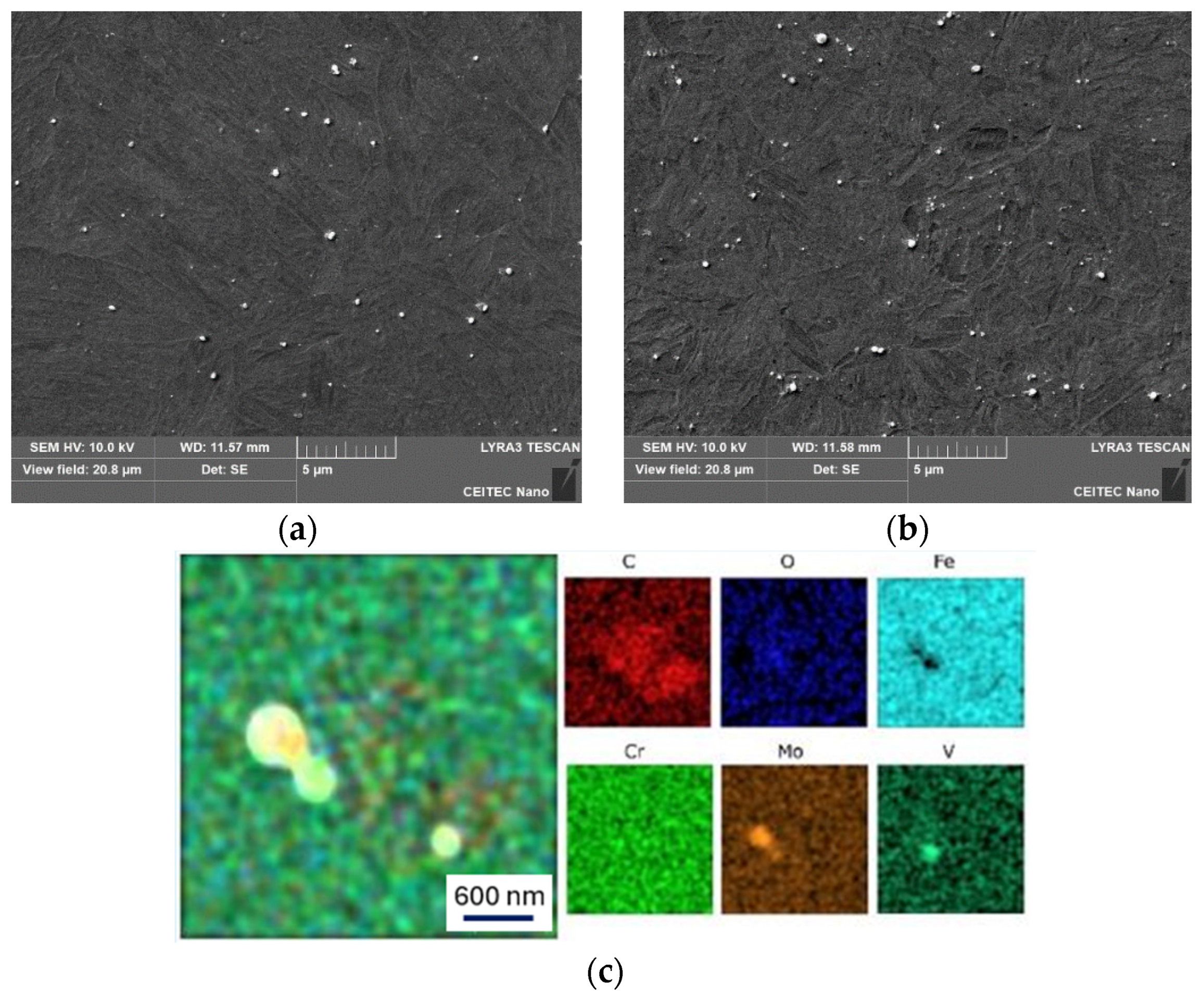
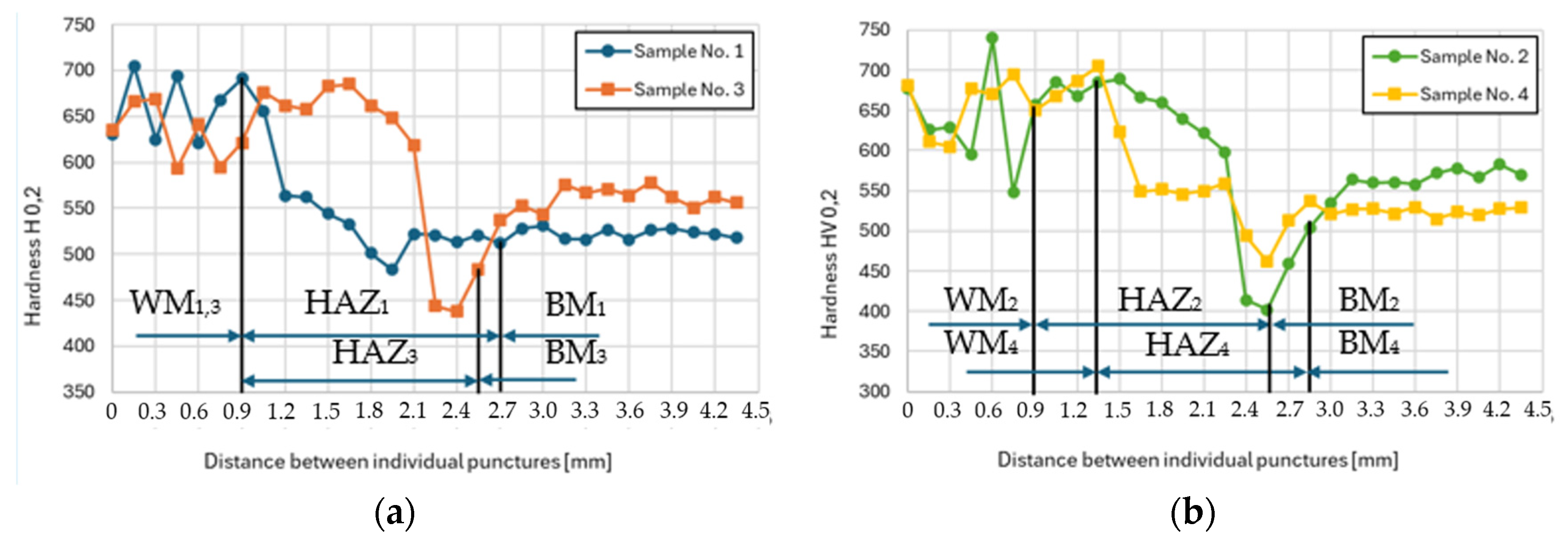
| C | Si | Mn | Cr | Mo | V | P | S | Fe | |
|---|---|---|---|---|---|---|---|---|---|
| BM | 0.33 | 0.17 | 0.38 | 4.93 | 2.00 | 0.47 | 0.0017 | 0.0005 | Rest. |
| TIG wire | 0.35 | 0.20 | 0.50 | 5.00 | 2.30 | 0.60 | - | - | Rest. |
| Sample | Strengthening Mechanism | Welding Current [A] | Welding Voltage [V] | Welding Speed [mm/s] |
|---|---|---|---|---|
| No. 1 | HT | 50 | 10 | 0.82 |
| No. 2 | RS | 1.34 | ||
| No. 3 | HT | 70 | 13 | 1.44 |
| No. 4 | RS | 1.80 |
Disclaimer/Publisher’s Note: The statements, opinions and data contained in all publications are solely those of the individual author(s) and contributor(s) and not of MDPI and/or the editor(s). MDPI and/or the editor(s) disclaim responsibility for any injury to people or property resulting from any ideas, methods, instructions or products referred to in the content. |
© 2024 by the authors. Licensee MDPI, Basel, Switzerland. This article is an open access article distributed under the terms and conditions of the Creative Commons Attribution (CC BY) license (https://creativecommons.org/licenses/by/4.0/).
Share and Cite
Izák, J.; Benč, M.; Kunčická, L.; Opěla, P.; Kocich, R. Influence of Imposed Strain on Weldability of Dievar Alloy. Materials 2024, 17, 2317. https://doi.org/10.3390/ma17102317
Izák J, Benč M, Kunčická L, Opěla P, Kocich R. Influence of Imposed Strain on Weldability of Dievar Alloy. Materials. 2024; 17(10):2317. https://doi.org/10.3390/ma17102317
Chicago/Turabian StyleIzák, Josef, Marek Benč, Lenka Kunčická, Petr Opěla, and Radim Kocich. 2024. "Influence of Imposed Strain on Weldability of Dievar Alloy" Materials 17, no. 10: 2317. https://doi.org/10.3390/ma17102317






